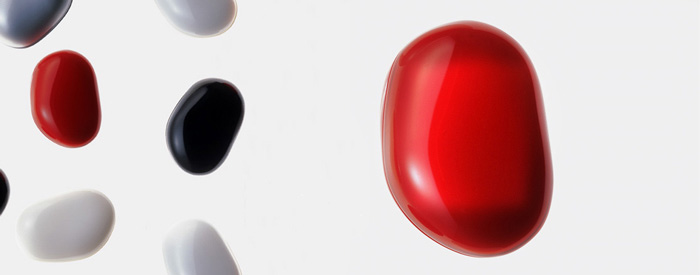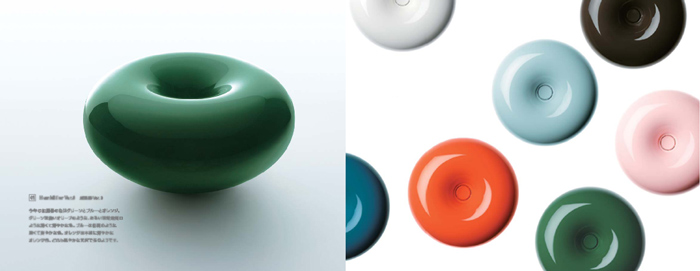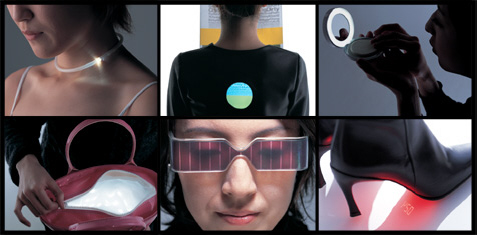Design Studio Review: Naoto Fukasawa
According to how much resonance the article about designer Sam Hekte received , I want to continue and complete the topic begun in that article.
The concept of the environment, as practice shows, is not always perceived adequately. Often the environment or context is considered as something separate from a person, inherent in a certain crowd. Perhaps this was how the modernists of the 50s – 60s considered Wednesday, and judging by our “sleeping bags”, they managed to put their views into practice. But now in the West and the East (that is, not ours;)) a somewhat different trend is emerging - an environment for each person individually, for personality and character, for the subconscious. Europeanizing the expression makoto I can say this: the manifestation of the nature of a thing is a subtle allusion to the subconscious and genetic memory of a person about a thing. It seems that this is how designer Naoto Fukasawa (Naoto Fukasawa) explains your theory of "body memory."

Mobile phone
')
Unfortunately, within the framework of one article it is difficult to embrace all that is interesting, which is connected with one or another author. Therefore, I will try to disclose what was not told about Hekte here. Fortunately there is a reason.
So, instead of pouring water about who was born-married where, I will go further - in the 20s of the XX century and further in the 50s. It was then that the world was overwhelmed with theories of psychoanalysis and existentialism. Freud, Berdyaev, Marcel Duchamp, Jackson Pollock, Dali and a lot of other representatives of philosophy and culture took advantage of the moment (2 world wars - which is no reason) and began to study their reflections, delve into the subconscious and come to important conclusions today: the body has memory and the person is a person thanks to these memories. The body remembers not only what happened to it in the womb, during birth, in childhood and yesterday, but also has prehistoric memories - wind noise, birds singing, stone roughness and grass softness - all this is in “active memory”.
We can also say - a thing is clean or not just by looking at it. Light or heavy - seeing how the other person carries it.

Humidifier
“Developing the idea of the role of instinct in design, Naoto and I came up with the concept of“ active memory. ” Our mind and body are associated with specific objects, even when we are not aware of it. We can feel the size of a pack of chewing gum in our pocket, although we don’t touch it. Our memory is so strong that if we put a piece of wood of the same size in our pocket, there will be a feeling of something familiar. We began to use this phenomenon, developing products for which there is no developed technology and a clearly formed typology. And the point here is not in nostalgia, but in a deep attitude towards design, ”says Sam Hekt about working at IDEO with Naoto Fukasawa. He adds: “Successful sales of a particular subject depend on a number of factors, and one of them is the presence of an internal connection between technology and man. Since people know what a phone is, they mostly guess what to do with it. But when it was necessary to come up with the design of an MP3 player - a technology that did not exist before - the direction of movement suggested Walkman, thanks to which the idea of a personal music player was formed. All these devices are constantly changing, but, as a rule, the most successful are models with the most natural typology. ”

DVD-MD player + remote control / portable MD player
Naoto Fukasawa is one of the most sought-after Japanese designers in the world. But, what is most strange, while one of the most sought after designers in their homeland. He heads up. supervises or consults about 5 companies at the same time. As a design director for Plus-minus-zero ( Plus-minus-zero , ± 0), he heads the technical direction in the giant Muji , advises (and previously served as director) global company IDEO. He also created (together with IDEO and Sam Hecht) and heads the creative workshop Without Thought! ("Without hesitation!")

LCD TV and remote control, developed during the Without thought! Study and included in the + -0 product line
Given all this, now you can carefully look at the work of Fukasawa. In each work we can notice that the most subtle contact between a person and an object. The phone is shaped and feels like a stone, it is pleasant to turn it in your hands or just squeeze, feeling its “wrong”, the remote mixes a feeling of joy, protection and tenderness. I especially like the humidifier - this, like the telephone in the form of a stone, is a particularly accurate indicator of the loyalty of Fukasawa's ideas. In this form is concentrated purity and freshness! The DVD and MD player is cleared of everything superfluous, leaving only the main functions brought, almost to the toy sense (by the way, one more typology has become clear - video is entertainment, fun).

Photos from the international design exhibition in Cologne and Stockholm
About how open the mind of this person can be judged by the unique project Without Thought! ..
He brought together designers from various companies that produce various equipment, telephones, cars, etc. These are people from competing corporations and occupying approximately one position - art director, chief designer, etc. Combining them under one roof, he chose a theme for the vector and gave three days to think. As a result, creative people working for large corporations, but occupied there by organizational work rather than creative work, united in creative groups and brainstormed to break down such barriers as competition and limitations within their own specialization.

8 "TV for ± 0
The project was conceived as a three-day workshop, stimulating creative energy for development and visualization. But after two years (and, accordingly, two studies conducted), the organizers decided to turn the project into something more promising. This time the task was set as follows: three days to brainstorm with the further implementation of the project. The project participants continued to maintain contact and a cooperative atmosphere for three months in order to bring their ideas to realization. Later, the items were exhibited at the Japanese exhibition of progressive design OZONE and ordinary people could touch and try out these intuitive things in action (from Japanese the name of the project translates as “Instinct does not think”).


The results of the project "Do not hesitate!"
Each exhibition had its own idea, theme. In one, it was a handrail in the metro, in the other, the adaptation of IT technologies to clothing. But on the topic of the last exhibition I want to focus. “Speaking about design, it is impossible not to admit that the surprise that we experience when we first look at the subject is that the first“ Wow! ”Is important. But the true essence of the design is “Wow!”, Which we pronounce later, when using the thing, we discover something that we had not noticed before ... ”.
And finally, as has happened, I want to show my favorite thing with this author: CD player, which has only two options - “on” and “off”. The feeling of Zen with this thing I just rolls over%) What do you want!
Invisible speakers in a wall-mounted CD player occupy the entire front of the device.
Its simple form resembles a fan - I think the allusion is clear?

A few links:
UPD : I forgot to mark the sources: MONITOR Unlimited # 19, 25, 26; designboom.com; plusminuszero.com; imm-cologne.com ; as well as the above.
The concept of the environment, as practice shows, is not always perceived adequately. Often the environment or context is considered as something separate from a person, inherent in a certain crowd. Perhaps this was how the modernists of the 50s – 60s considered Wednesday, and judging by our “sleeping bags”, they managed to put their views into practice. But now in the West and the East (that is, not ours;)) a somewhat different trend is emerging - an environment for each person individually, for personality and character, for the subconscious. Europeanizing the expression makoto I can say this: the manifestation of the nature of a thing is a subtle allusion to the subconscious and genetic memory of a person about a thing. It seems that this is how designer Naoto Fukasawa (Naoto Fukasawa) explains your theory of "body memory."

Mobile phone
')
Unfortunately, within the framework of one article it is difficult to embrace all that is interesting, which is connected with one or another author. Therefore, I will try to disclose what was not told about Hekte here. Fortunately there is a reason.
So, instead of pouring water about who was born-married where, I will go further - in the 20s of the XX century and further in the 50s. It was then that the world was overwhelmed with theories of psychoanalysis and existentialism. Freud, Berdyaev, Marcel Duchamp, Jackson Pollock, Dali and a lot of other representatives of philosophy and culture took advantage of the moment (2 world wars - which is no reason) and began to study their reflections, delve into the subconscious and come to important conclusions today: the body has memory and the person is a person thanks to these memories. The body remembers not only what happened to it in the womb, during birth, in childhood and yesterday, but also has prehistoric memories - wind noise, birds singing, stone roughness and grass softness - all this is in “active memory”.
We can also say - a thing is clean or not just by looking at it. Light or heavy - seeing how the other person carries it.

Humidifier
“Developing the idea of the role of instinct in design, Naoto and I came up with the concept of“ active memory. ” Our mind and body are associated with specific objects, even when we are not aware of it. We can feel the size of a pack of chewing gum in our pocket, although we don’t touch it. Our memory is so strong that if we put a piece of wood of the same size in our pocket, there will be a feeling of something familiar. We began to use this phenomenon, developing products for which there is no developed technology and a clearly formed typology. And the point here is not in nostalgia, but in a deep attitude towards design, ”says Sam Hekt about working at IDEO with Naoto Fukasawa. He adds: “Successful sales of a particular subject depend on a number of factors, and one of them is the presence of an internal connection between technology and man. Since people know what a phone is, they mostly guess what to do with it. But when it was necessary to come up with the design of an MP3 player - a technology that did not exist before - the direction of movement suggested Walkman, thanks to which the idea of a personal music player was formed. All these devices are constantly changing, but, as a rule, the most successful are models with the most natural typology. ”

DVD-MD player + remote control / portable MD player
Naoto Fukasawa is one of the most sought-after Japanese designers in the world. But, what is most strange, while one of the most sought after designers in their homeland. He heads up. supervises or consults about 5 companies at the same time. As a design director for Plus-minus-zero ( Plus-minus-zero , ± 0), he heads the technical direction in the giant Muji , advises (and previously served as director) global company IDEO. He also created (together with IDEO and Sam Hecht) and heads the creative workshop Without Thought! ("Without hesitation!")

LCD TV and remote control, developed during the Without thought! Study and included in the + -0 product line
Given all this, now you can carefully look at the work of Fukasawa. In each work we can notice that the most subtle contact between a person and an object. The phone is shaped and feels like a stone, it is pleasant to turn it in your hands or just squeeze, feeling its “wrong”, the remote mixes a feeling of joy, protection and tenderness. I especially like the humidifier - this, like the telephone in the form of a stone, is a particularly accurate indicator of the loyalty of Fukasawa's ideas. In this form is concentrated purity and freshness! The DVD and MD player is cleared of everything superfluous, leaving only the main functions brought, almost to the toy sense (by the way, one more typology has become clear - video is entertainment, fun).

Photos from the international design exhibition in Cologne and Stockholm
About how open the mind of this person can be judged by the unique project Without Thought! ..
He brought together designers from various companies that produce various equipment, telephones, cars, etc. These are people from competing corporations and occupying approximately one position - art director, chief designer, etc. Combining them under one roof, he chose a theme for the vector and gave three days to think. As a result, creative people working for large corporations, but occupied there by organizational work rather than creative work, united in creative groups and brainstormed to break down such barriers as competition and limitations within their own specialization.

8 "TV for ± 0
The project was conceived as a three-day workshop, stimulating creative energy for development and visualization. But after two years (and, accordingly, two studies conducted), the organizers decided to turn the project into something more promising. This time the task was set as follows: three days to brainstorm with the further implementation of the project. The project participants continued to maintain contact and a cooperative atmosphere for three months in order to bring their ideas to realization. Later, the items were exhibited at the Japanese exhibition of progressive design OZONE and ordinary people could touch and try out these intuitive things in action (from Japanese the name of the project translates as “Instinct does not think”).


The results of the project "Do not hesitate!"
Each exhibition had its own idea, theme. In one, it was a handrail in the metro, in the other, the adaptation of IT technologies to clothing. But on the topic of the last exhibition I want to focus. “Speaking about design, it is impossible not to admit that the surprise that we experience when we first look at the subject is that the first“ Wow! ”Is important. But the true essence of the design is “Wow!”, Which we pronounce later, when using the thing, we discover something that we had not noticed before ... ”.
And finally, as has happened, I want to show my favorite thing with this author: CD player, which has only two options - “on” and “off”. The feeling of Zen with this thing I just rolls over%) What do you want!
Invisible speakers in a wall-mounted CD player occupy the entire front of the device.
Its simple form resembles a fan - I think the allusion is clear?

A few links:
- Previous Design Studio Reviews in Habré:
- You can also look at the works of N.Fukasawa:
- Interview and biography from Designboom
- Herald Tribune article
UPD : I forgot to mark the sources: MONITOR Unlimited # 19, 25, 26; designboom.com; plusminuszero.com; imm-cologne.com ; as well as the above.
Source: https://habr.com/ru/post/13161/
All Articles